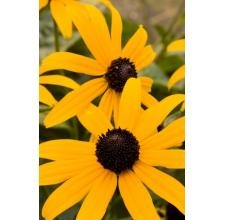Tough, drought-tolerant and abundant bloomers, Black-eyed Susans (Rudbeckia) make for a low-fuss, superstar addition to the warm-season garden. Once you plant them, be ready to see them come back year after year, because Rudbeckia re-seed themselves, and muscle out weeds and other plants that try to grow in their area.
Planting Seeds
-
 Rudbeckia can be sown directly outdoors.
Rudbeckia can be sown directly outdoors.Plant Rudbeckia seeds in the garden after all danger of frost, when soil temperatures are between 70 and 75 degrees. They should germinate in five to 10 days. Seeds can be started indoors, and the University of Florida Extension Service notes that the seeds will often germinate faster this way. Like many wildflowers, Rudbeckia seeds need only a light covering of soil. The Extension Service also recommends giving wilting transplants a couple of days to recover.
Planting Nursery-Grown Plants
-
 Cluster of Black-eyed Susans
Cluster of Black-eyed SusansRudbeckia can be planted from March to May in the southern states, depending on the hardiness zone. In northern states, wait until June or July. Do not cover stems or foliage with soil when planting, and remember to plant in well-drained soils. Rudbeckia has a high drought tolerance, but water occasionally to establish after transplanting. Give each plant 12 to 18 inches of space, depending on the variety and how much of a cluster effect is desired.
Growing Outdoors
-
 If you plant Rudbeckia two years in a row, re-seeded plants will alternate blooming years.
If you plant Rudbeckia two years in a row, re-seeded plants will alternate blooming years.Choose a sunny spot for your Rudbeckia, and water infrequently. Mulching is usually not necessary (because Black-eyed Susans are very competitive and drought tolerant), but may be done where weeds are problematic. Most Black-eyed Susans are biennial, so the first year after sprouting, they do not produce blooms. During the second year they will bloom, then die at the end of the year. Compost may be used to improve health and performance, but chemical fertilizers are generally not required for wildflowers. Instead, remove spent blooms to encourage Rudbeckia to re-flower.
Considerations
-
 Blue salvia, planted in front of Rudbeckia for contrast
Blue salvia, planted in front of Rudbeckia for contrastThe Black-eyed Susan’s profuse flower production makes it a welcome addition to a butterfly garden or a wildflower meadow. Its foliage stands approximately 2 feet high and the blooms tower over this. It makes a good medium-height cluster in the landscape, with shorter plants of a contrasting or complementing color in front and taller plants providing some vertical interest behind. The University of Florida lists Rudbeckia as a highly salt-tolerant plant that can be used near beaches. Its drought tolerance makes Rudbeckia a welcome sea of color for xeriscape gardens
Microbal Pests
-
 Rudbeckia in the evening: not a good time to water.
Rudbeckia in the evening: not a good time to water.The University of Minnesota Extension Service lists Septoria, Cylindrosporium and Ramularia leaf spot fungi as pests of Rudbeckia. They are difficult to distinguish from one another, because they all appear as small brown lesions on the leaves. Prevent by refraining from watering foliage, especially at night. Prevent and treat with a copper-containing fungicide. The best cure is prevention for the bacteria that cause angular leaf spot. The extension service recommends planting generic varieties of Rudbeckia, which have a better resistance. Aster yellows are a bacteria-like pest that cause odd dwarfing and leaves sprouting from flowers. The only control for this issue is to seek out infected plants, remove them and destroy them before leaf-hoppers can vector the disease to other susceptible garden flowers. Powdery mildew may show up in late summer, but generally is only unsightly–not lethal.


Deprecated: strpos(): Passing null to parameter #1 ($haystack) of type string is deprecated in /home/agriviek8Qv/agriviet.net/public_html/wp-includes/comment-template.php on line 2522